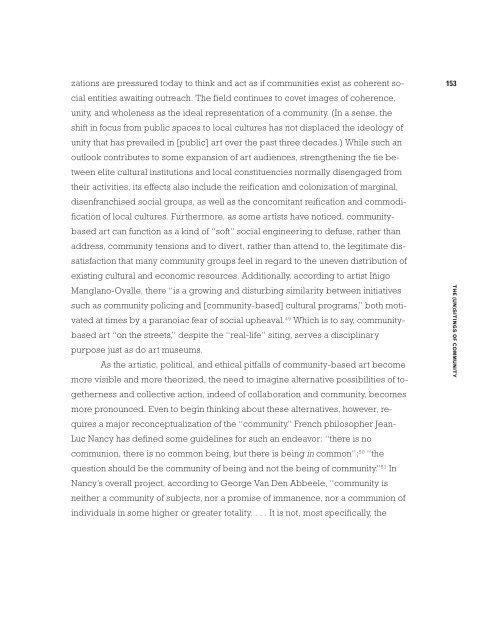ONE PLACE AFTER ANOTHER - Monoskop
ONE PLACE AFTER ANOTHER - Monoskop
ONE PLACE AFTER ANOTHER - Monoskop
Create successful ePaper yourself
Turn your PDF publications into a flip-book with our unique Google optimized e-Paper software.
zations are pressured today to think and act as if communities exist as coherent social<br />
entities awaiting outreach. The field continues to covet images of coherence,<br />
unity, and wholeness as the ideal representation of a community. (In a sense, the<br />
shift in focus from public spaces to local cultures has not displaced the ideology of<br />
unity that has prevailed in [public] art over the past three decades.) While such an<br />
outlook contributes to some expansion of art audiences, strengthening the tie between<br />
elite cultural institutions and local constituencies normally disengaged from<br />
their activities, its effects also include the reification and colonization of marginal,<br />
disenfranchised social groups, as well as the concomitant reification and commodification<br />
of local cultures. Furthermore, as some artists have noticed, communitybased<br />
art can function as a kind of “soft” social engineering to defuse, rather than<br />
address, community tensions and to divert, rather than attend to, the legitimate dissatisfaction<br />
that many community groups feel in regard to the uneven distribution of<br />
existing cultural and economic resources. Additionally, according to artist Iñigo<br />
Manglano-Ovalle, there “is a growing and disturbing similarity between initiatives<br />
such as community policing and [community-based] cultural programs,” both motivated<br />
at times by a paranoiac fear of social upheaval. 49 Which is to say, communitybased<br />
art “on the streets,” despite the “real-life” siting, serves a disciplinary<br />
purpose just as do art museums.<br />
As the artistic, political, and ethical pitfalls of community-based art become<br />
more visible and more theorized, the need to imagine alternative possibilities of togetherness<br />
and collective action, indeed of collaboration and community, becomes<br />
more pronounced. Even to begin thinking about these alternatives, however, requires<br />
a major reconceptualization of the “community.” French philosopher Jean-<br />
Luc Nancy has defined some guidelines for such an endeavor: “there is no<br />
communion, there is no common being, but there is being in common”; 50 “the<br />
question should be the community of being and not the being of community.” 51 In<br />
Nancy’s overall project, according to George Van Den Abbeele, “community is<br />
neither a community of subjects, nor a promise of immanence, nor a communion of<br />
individuals in some higher or greater totality. ... It is not, most specifically, the<br />
153<br />
THE (UN)SITINGS OF COMMUNITY

















